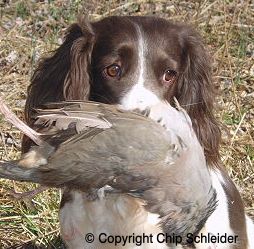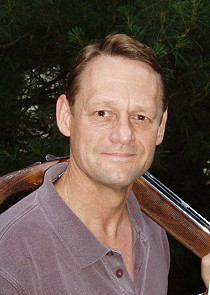
 The screen door slammed shut and I stepped into the chill of a near zero, pitch black, South Dakota, November morning. The dashboard thermometer read four degrees as I started the car, the intense cold penetrating to my very bones. I recognize that a mere four degrees to my Midwestern friends is, I am reliably informed, still technically classified as bikini weather. But to a Southern born and raised male, a four degree temperature gives one pause for reflection.
While the car’s heater was struggling to breathe warmth into the cold, dead interior of my Explorer, I checked the equipment and groaned out loud when I hefted the frozen water jug that I had neglected to bring inside the previous evening. Now I would have to buy bottled water for Dixie and Arwen to ensure that they would have sufficient water for the day’s hunt. As I hefted the frozen jug and closed the tailgate on the Explorer, Tony Roettger stuck his head out of the door, and asked, "Hey Chip, is there any coffee left?"
"I’m not sure man," I replied as I sipped the last cup the pot had contained with a wicked grin on my face, "you might have to make some more." Ah, the trials and tribulations of sleeping in.
An hour later, we found ourselves thoroughly caffeinated in Hutch’s Café - a well know Presho restaurant and watering hole, and in fact, the only one in town. After consuming wagon wheel-sized pancakes, eggs and fresh sausage patties, our merry band of pheasant hunters waddled back to the trucks and checked on dogs. Dixie and Arwen were warmly ensconced in their crates, but shivered with anticipation of the hunt. Dixie’s tail rhythmically thumped against the side of her kennel.
The group shared the dogs’ eagerness.
This year, our party consisted of Tony, my brother, Pete, my youngest son, Zander, and me. Christian was, at that time, an Army Second Lieutenant stationed in Korea, and, much to our collective disappointment, not able to join us. As we pulled up to Ron Brodrecht’s house a block from Hutch’s, I felt very good. Dixie had made significant progress since the previous year’s hunting debacle in the vast cornfields of South Dakota. Vividly, I recalled the rush of the wind, the woosh of the wings and the hundreds and hundreds of pheasants that Dixie flushed in waves - completely out of range of our guns - as she wildly chased running pheasants down the corn rows. I was determined that this year would not be a repeat of the previous fall.
Pleasantries, in this case, obligatory remarks questioning the legitimacy of one’s birth and questions concerning the absence or presence of one’s legal father at the moment of one’s conception, were exchanged and we headed for the shooting fields. I followed Ron’s venerable, rust encrusted Suburban to the first area. I had asked that we hunt CRP land first to warm up Dixie and Arwen before they encountered the seductive, yet treacherous, cornfields and that is where we were headed.
There was a light snow cover on the ground and the temperature had warmed up considerably to a balmy eleven degrees as we pulled up and parked at our first stop of the day. Reluctantly, we emerged from the warm cocoons of our over-heated SUVs and donned vests, assembled shootin’ irons and unboxed dogs.
The first area we planned to hunt was an extensive coulee with heavy cover on its banks extending for approximately ten to fifteen yards on each side. It was excellent habitat. Blockers established and breeches snapped shut, I gave Dixie the "get out" command. Tony was hunting Sky, his extremely talented male English cocker who is the sire of my son Christian’s dog Duke. The dogs braced beautifully and in no time we had put up a couple of cock pheasants. Tony had the position and connected on both birds only five minutes into the hunt. Dixie was steady as a rock. She honored Sky’s retrieve of both pheasants. A few minutes later, Dixie flushed a couple of hens. Again, she hupped beautifully as the two birds caught the wind and were rocketed to safety. I recalled her, and gave the springer a nice ear scratch, as she grinned at me.
Shortly after the hen flush, Dixie put up a nice prairie chicken and I connected with my sixteen gauge Rizzini at about forty yards. I was amazed. Dixie had remained virtually motionless with her rump on the ground until I released her for the retrieve. Accepting the prairie chicken, I dropped to one knee, my open shotgun resting on the other, vigorously rubbed Dixie’s ears and gave her a huge kiss on the head. Bursting with pride, I turned and displayed the chicken to Tony, who smiled and nodded approvingly. It had all come together. The long hard work of the late summer and early fall had paid off.
Three and one half months earlier and in the heat of a Virginia summer, Dixie and I began training for the South Dakota hunt in earnest. I obtained the name of a farmer whose son trapped pigeons for three bucks a head. This was a hit and miss business, as the son’s pigeon stock depended heavily upon the neighboring farmer’s barn pigeon stock at the moment. As luck had it, the farmer’s barn was ripe for the pickings and we struck a deal. I drove an hour and half, paid the budding entrepreneur a whopping ninety dollars for thirty birds, and drove home to the sound of pigeons cooing and the odoriferous fragrance of fresh pigeon dung in the back of my Explorer. Door, my bride of many years, was not amused when I put the cage in the garage, fed and watered the birds.
I started Dixie off on pigeons rather slowly. In the seventh article of this series, I described how I had introduced Dixie to the age of microchips, electronics and radio frequencies (there is thus no reason to revisit her electronic collar-conditioning here). Suffice it to say that she was sufficiently conditioned to the e-collar to enable the next phase of her training. I took the e-collar out of my training bag and Dixie immediately began jumping straight up in the air in anxious anticipation of playtime. Affixing the collar to her neck, I put her in a holding kennel in the garage while I got a pigeon, dizzied it and placed it in a large forsythia bush in our backyard. Quickly, I went back to the garage and got Dixie out of the box. I gave her the "get out" command and she began quartering. It took only moments for her to make scent.
She dove into the forsythia. Moving quickly, she flushed the bird and I hit the whistle only after the bird was well out of her grasp. She started to break, but I gave her a small 'nick' on the lowest possible power setting and hit the whistle again. She stopped, hupped and watched the bird fly away. I was elated.
Because I live in a suburb environment in a Virginia county that precludes discharge of firearms within the county limits, all of these birds were fly aways. We quickly went through the thirty pigeons. Not long after my last pigeon took flight while Dixie watched longingly from her hupped position, I received a phone call from my across the street neighbor. "Hey Nancy," I said, "How’s it going?"
She got right to the point, "Uh...Chip, have you noticed a lot increased pigeon activity around the neighborhood lately?"
"Uh...gee Nanc, uh...no not really," I mumbled numbly.
"Well, Sante [her husband] keeps getting pigeon droppings on his new Lexus every time he takes it to the car wash. It’s almost like the birds are targeting his car," she explained.
"Gosh, Nanc that’s a tough break," I mused out loud sympathetically, "I’ll keep an eye out though." As I hung up the receiver, I smiled to myself. It’s not too often that one gets double value from training birds. Sante is a lobbyist on Capitol Hill.
In late August, my bird supplier ran out of pigeons, and I was forced to invest in chukar partridges as my training bird. The impact on my pocket book was offset by the realism of the training. Chukars, at least in my mind, more closely approximate game birds than feral pigeons and when flight conditioned, give a much better flush. Again I planted the birds around my house and Dixie readily found and flushed them. She was rock steady throughout this process and the birds escaped in relatively good shape. Again, a day or so after the last bird flew the proverbial coop, I received another telephone call from Nancy. “Hey Chip,” she jumped right in, “have you seen any strange looking birds around here lately? Sante saw one that he thinks is a giant cedar waxwing. He is thinking about calling the local paper and reporting it. What do you think?"
"Gee Nanc,... I don't know. I... uhh... really...uhh...haven’t seen any giant cedar waxwings around here." As I hung up the phone, I looked out the window to see Sante trying to take a picture of a chukar sitting on top of his roof. Looking through the viewfinder of his camera he stumbled into the holly bushes around his house. The chukar, startled at the noise, flushed magnificently and flew off toward our neighborhood’s common area. Sante struggled to free himself from the bushes.
The rest of that cold November day we hunted pheasants, sharptailed grouse, and prairie chickens. We actually took more grouse that day than we did pheasants, and Dixie had performed superbly in the cornfields as well as the CRP of South Dakota. Over a post-hunt beer, I reflected on our day and her performance. As a result of the summer training we did, the young springer had truly regained her poise. Winston Churchill had it about right when he said, "Everyone has his day and some days last longer than others."
Author’s note: this is the eighth in a series of articles that chronicle both the development of a talented young spaniel and the rights of passage of an inexperienced trainer and handler.
|
|
| Bookstore | Bill Fawcett Reviews | Bookshelf | Advertise | Classifieds | Resources | Events | Point Standings | Archives | |
|
|
Copyright © Spaniel Journal & L Baughan Webdesign, 2002-2006, all rights reserved worldwide |
|

